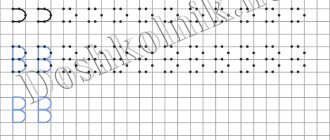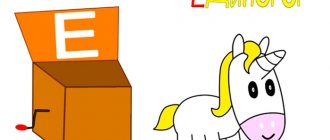Notes on teaching literacy in the preparatory group. Sounds “T-T”, letter “T”
Goal : formation of reading skills, development of phonemic hearing, development of memory and attention, development of motor functions. Coding development. Formation of the ability to determine the location of sound in a word, development of grapho-motor functions.
Materials : worksheet, simple and colored pencils, mosaic, cards
Lesson plan.
1. Introduction to the topic. 2. Development of the articulatory apparatus. Pure talk. 3. Learning to read. Sound and letter T. 4. Consolidating the image of the letter. Letter T. 5. Sound analysis of words. Sounds T and T. 6. Outdoor game. Days of the week. 7. Work on the syllable structure of the word. Scheme. 8. Learning to read. Words. 9. Massage break. Cones. 10. Dictation. Syllables. 11. Development of attention. Words. 12. Development of phonemic hearing. Repeat the syllables. 13. Work on proposals. Scheme. 14. Finger gymnastics. Spider. 15. Preparing your hand for writing. Animals. 16. Summary.
Progress of the lesson.
Children are asked to name pictures whose names contain the sound T(TH).
Development of the articulatory apparatus. Pure talk.
The teacher invites the children to repeat after him the pure sayings in a whisper and slowly. And then - loud and fast.
La-la-la - milk... (drank). Li-li-li - berries from the forest... (brought). Mo-mo-mo - let's eat... (popsicle). Ri-ri-ri - on the branches... (bullfinches). Ay-ay-ay - here comes the month... (May).
Learning to read. Sound and letter T.
- Listen to the words and name the first sound in the words. - Current, slippers, rags, plate, cake, etc. - That's right, this is the sound T. - Today we are with you with the letter and the sound T. - Say the sound T. - Is the T sound a consonant or a vowel? Consonant. Why did you decide so? The air meets an obstacle, the lips close. — Is the T sound voiced or voiceless? To answer the question, children cover their ears with their palms and pronounce the sound T. If the ears “buzz,” it is ringing. If they don't buzz, they're deaf. - That's right, the T sound is unvoiced. — The T sound can be soft or hard. - Let's choose words with the sound T. - Poplar, tractor, stool, etc. - Let's choose words with the sound Th. — Dough, body, vice, hoe, etc. - This means the sound T: consonant, deaf, can be soft and hard. - The sounds T and Tb are indicated on the letter by the letter T. The teacher shows the children a card with the letter T. - What does the letter T look like? — Let's lay out the letter T from the mosaic. The teacher gives the children a mosaic and shows a pre-made sample. Following the example of the teacher, children lay out the letter T from the mosaic.
Fixing the image of the letter. Letter T.
The teacher shows the children various cards with letters. - Name the letter. - Find and show the letter T. - Draw the letter T with your finger in the air. The teacher gives the children a worksheet. — Color the letter T with a pencil. - Circle the letters T. - Think of words starting with the sounds T and T.
Outdoor game. Days of the week.
Children stand in a circle. On Monday I swam (pretend swimming) And on Tuesday I painted. (Pretend to draw.) On Wednesday I took a long time to wash my face, (we wash my face.) And on Thursday I played football. (Running in place.) On Friday I jumped, ran, (jumped.) Danced for a very long time. (We spin around in place.) And on Saturday, Sunday (claps hands.) I rested the whole day. (Children squat down with their hands under their cheeks and fall asleep.)
Sound analysis of words. Sounds T and T.
The teacher draws the children’s attention to the second task on the worksheet. - Name the objects that are shown on the worksheet. - Color the objects whose names contain the sounds T and T. - Name the objects that you painted. (Rooster, dragonfly, flower, cat).
Work on the syllabic structure of the word. Scheme.
The teacher draws the children's attention to the second task. - Name the drawn objects again. — Determine the number of syllables in words. - Which syllable in words is stressed? For example, in the word FENCE the stress falls on the second syllable. - Make up syllable patterns for the words: DRAGONFLY and COCKS.
Learning to read. Words.
We invite children to read the words first line by line and then in columns. - Divide the words into syllables. - Put emphasis on words. - Underline the letter T in the words. - Circle the longest word in an oval. Which word did you circle? (Plate).
Massage break. Cones.
The squirrel collected cones (we transfer the cone from one hand to the other), for the raccoon and for the mouse. One, two, three, four, five (we squeeze the cone with our palms for each count), I’ll find the cone again (we roll the cone between our palms). Three for the raccoon and three for the mouse (we squeeze the pine cone with one hand, then with the other), the rest for whom are the cones (we roll the pine cone between our palms)?
Dictation. Syllables.
The teacher dictates the syllables - TA, TO, TU, YOU, TI, TE. - Emphasize the syllables TU, TE, TO.
Development of attention. Words.
The teacher draws the children's attention to the next task on the worksheet.
- Cross out the extra letters and read the resulting words.
- What words did you come up with?
- Come up with a sentence consisting of three words with the word KERCHIEF.
Development of phonemic hearing. Repeat the syllables.
The teacher quickly and clearly names a number of syllables, and the children repeat. Children can repeat the words in chorus or one at a time. Syllables: kta-kto-ktu-kty; who-who-who-who-who; who-who-who-who; Who-who-who-who.
Working on proposals. Scheme.
The teacher draws the children's attention to the task on the worksheet with sentences.
- Read the sentences.
- Who is the first sentence talking about? What was the wolf doing?
- Who is the second sentence talking about? What did the fox steal?
- Create proposal outlines.
- How many words are in the first sentence? In the second?
- Based on the diagrams, come up with sentences about forest animals.
Finger gymnastics. Spider.
Once upon a time there lived a little spider (hands together, thumbs touching). A spider ran and ran across the grass (we move our fingers on the table), Saw a large flower and climbed onto it (raise our arms up). And the flower swayed from side to side (wrists together, fingers spread, sway). Suddenly a cloud appeared in the sky (we make an oval with our hands). It began to rain heavily (we tap our fingers on the table). And the flower closed its petals (we lean our palms against each other). A strong storm has begun (we strongly swing the arms from side to side). But the sun appeared in the sky (we place one palm on top of the other with fingers spread) and drove away the cloud (we make a sharp movement to the right). The spider got out (we move our fingers and lower our hands down) and ran away (we hide our hands under the table).
Preparing your hand for writing. Animals.
— Help the animals go to bed in their beds.
Summarizing.
Tatarnikova Natalya Vladimirovna Teacher-speech therapist, MBDOU “Kindergarten No. 40, Yelets, Lipetsk region.
"Games with letters"
Prepared by V.V. Minakova, teacher-defectologist.
"Circle the letter ." The adult invites the child to carefully examine, recognize and name the familiar letter that is written in dotted lines, and complete it with “Find the letter.” The adult invites the child to find the letter being studied among other letters written in the same regular font. For example. “T” (can be any) T. P V S M T T K I N V L T L T S B D T S CH E K R T F Y T B T T
"Find the letter ." The adult invites the child to find different images of the letter being studied, which are written in different fonts, among other letters. For example: “Z”. T P Z Sh L X Z R
“Name the letter.” The adult invites the child to find a letter among the letters crossed out in various ways P T V V R S V D I M V H V V T V
"Find the letter ." The adult invites the child to find the letter he named in a series of graphically similar letters, for example, the letter “G”: P G T R T G P P G.
“Complete the letter .” The adult invites the child to carefully examine the familiar unfinished letter, name it and complete the missing elements “Find the mistake.” The adult invites the child to look at two images of the same familiar letter, one of which is written incorrectly. The child must cross out the incorrect picture of the letter “Find out the letter.” The child closes his eyes. At this time, the adult “writes” a letter familiar to him on the child’s hand. The child names which letter the adult “wrote” on his hand.
"Wonderful bag." The adult places three-dimensional letters familiar to the child, made of plastic, cardboard or wood, into an opaque bag. The child, with his eyes closed, takes a letter from the bag, feels it with both hands and names it.
“Fold the letter.” The adult asks the child to put together a whole image from the parts and name the resulting letter. (The card on which a letter familiar to the child is written is cut into several parts.)
“Lay out the letter .” An adult invites the child to lay out a letter familiar to him from various materials: mosaics, seeds, small nuts, seeds, buttons, branches, pieces of paper, counting sticks and thick threads.
"Make a letter ." An adult invites the child to make a letter he is familiar with from plasticine, wire or paper (first according to the model, and then on his own).
"Magic Pencil" The adult invites the child to trace a familiar letter along the contour, shade it in a certain way, or paint it over.
“Write the letter.” The adult invites the child to write a letter he knows with his finger in the air, or with a stick on wet sand or snow.
“Describe the letter .” The adult invites the child to tell what elements the familiar letter consists of and how they are located. For example: the letter "H " consists of two large vertical sticks and one small horizontal stick between them.
"Wizard ". The adult invites the child to lay out some letter familiar to him from counting sticks or bend from wire, and then “transform” it into another, graphically similar letter. “O” from wire and then “turn” it into the letter “C”; lay out the letter “N” from sticks , and then “turn” it into the letter “P” , etc.





